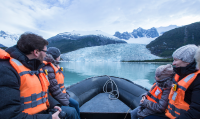A host of tour companies based in Patagonia can arrange birdwatching tours, which generally include all accommodations, food and transport for the duration of the trip. These range from three-day tours to 12-day excursions, some of which involve trips to see birdlife in other parts of Chile or Argentina beyond Patagonia.
You can also take three- to eight-night cruises that visit islands such as Isla Magdalena or have a stint of overland travel to see the king penguin colony at Bahía Inútil as part of their itinerary.
Many tour companies offer scheduled departures (i.e. a specific date on which a tour leaves) as well as the possibility of organizing a personalized itinerary around your dates, with the latter coming at an additional cost.
It’s also possible to travel independently and visit some of the areas mentioned in this guide. Place such as Torres del Paine National Park and Patagonia Park (both in Chilean Patagonia) are easily traversed on foot with plenty of opportunities for spotting native species, particularly if you’re armed with a good guidebook about the types of birds you can expect to see.
Other areas such as Tierra del Fuego in the far south of Patagonia and Ruta 40, a highway that connects Bariloche in the north of Patagonia with El Calafate and other towns further south, are easily accessed with a rental car and can provide opportunities for seeing bird and wildlife from the road.
Which Bird Species Will you be able to watch?
- Magellanic penguin (spheniscus magellanicus)
- The Magellanic penguin is the most populous species of penguin found in South America, with an estimated 800,000 breeding pairs in Chile and 900,000 in Argentina.
- Magellanic penguins are medium sized and identifiable by their white chests and the band of white feathers that cut below the throat.
- King penguin (aptenodytes patagonicus)
- The second largest penguin, the king penguin has an approximate population of 4.5 million birds.
- Their beaks are the longest of all penguins and they have bright black heads with orange spots on the side.
- South American tern (Sterna hirundinacea)
- The South American tern has a large, red beak and a black, cap-like patch of feathers on its head.
- It nests in large colonies on cliff tops and beaches.
- Imperial cormorant (leucocarbo atriceps)
- Of the four types of cormorant that breed in Patagonia (imperial, rock, red-legged and Neotropic), the imperial cormorant is the most populous.
- It is mainly black, with white feathers around its neck and belly.
- Upland goose (chloephaga picta)
- Male and female upland geese are very distinctive: the male has a white chest with white and black feathers along his wings, while the female is mainly brown with stripes of black feathers.
- They live in groups of thousands and are considered pests by farmers as they graze on pasture intended for cattle and sheep.
- Hooded grebe (podiceps gallardoi)
- Medium sized compared with other species of grebes, the hooded grebe is critically endangered according to the IUCN list of endangered species.
- They breed in colonies of over 100 pairs, although the rate of reproduction is very low, with an average 0.2 chicks reared per adult annually.
- Chilean flamingo (phoenicopterus chilensis)
- The Chilean flamingo lives in flocks of up to 10,000.
- They are identifiable from other flamingos by their long, grey legs with pink knees and their almost completely black bills.
- Darwin’s rhea (rhea pennata)
- A species of flightless bird, Darwin’s rhea have brown and white plumage and live in groups of up to 30 individuals.
- They measure up to 39-in. (100cm) tall and can outrun predators with speeds of up to 37 mph (60k/h).
- Lesser Horned Owl (bubo magellanicus)
- They hunt at night, with their diet mainly composed of rodents and insects.
- The lesser horned owl is a large species of owl that has pointed tufts on its ears and grey-brown plumage with narrow grey bars along the chest.
- Andean condor (vultur gryphus)
- The Andean condor is the largest flying bird in the world with a wingspan measuring up to 10-ft. 10-in (3.3 m).
- It is mainly black, with a ring of white feathers surrounding its neck and large white patches on their wings.
- Southern crested caracara (caracara plancus)
- The southern crested caracara is a bird of prey that is mainly brown but has a white neck and tail and orange coloring around its beak.
- Austral parakeet (enicognathus ferrugineus)
- The southernmost species of parakeet in the Americas, the Austral parakeet is one of the few non-tropical species of parrot.
- Their plumage is mainly green, with darker green and red patches on the tail and further red coloring around the beak and feet.
No comments yet
There are no comments on this post yet.






Leave a comment